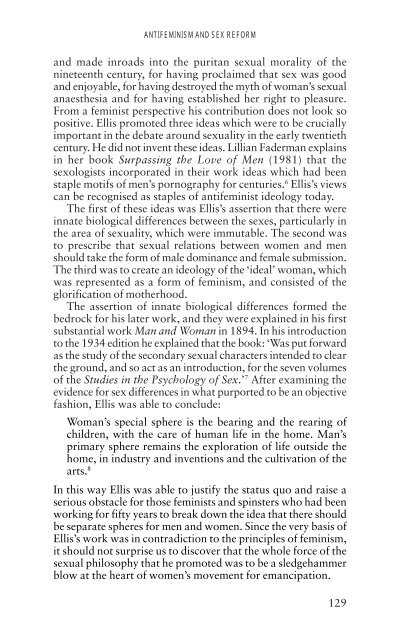The Spinster and Her Enemies - Feminish
The Spinster and Her Enemies - Feminish
The Spinster and Her Enemies - Feminish
You also want an ePaper? Increase the reach of your titles
YUMPU automatically turns print PDFs into web optimized ePapers that Google loves.
ANTIFEMINISM AND SEX REFORM<br />
<strong>and</strong> made inroads into the puritan sexual morality of the<br />
nineteenth century, for having proclaimed that sex was good<br />
<strong>and</strong> enjoyable, for having destroyed the myth of woman’s sexual<br />
anaesthesia <strong>and</strong> for having established her right to pleasure.<br />
From a feminist perspective his contribution does not look so<br />
positive. Ellis promoted three ideas which were to be crucially<br />
important in the debate around sexuality in the early twentieth<br />
century. He did not invent these ideas. Lillian Faderman explains<br />
in her book Surpassing the Love of Men (1981) that the<br />
sexologists incorporated in their work ideas which had been<br />
staple motifs of men’s pornography for centuries. 6 Ellis’s views<br />
can be recognised as staples of antifeminist ideology today.<br />
<strong>The</strong> first of these ideas was Ellis’s assertion that there were<br />
innate biological differences between the sexes, particularly in<br />
the area of sexuality, which were immutable. <strong>The</strong> second was<br />
to prescribe that sexual relations between women <strong>and</strong> men<br />
should take the form of male dominance <strong>and</strong> female submission.<br />
<strong>The</strong> third was to create an ideology of the ‘ideal’ woman, which<br />
was represented as a form of feminism, <strong>and</strong> consisted of the<br />
glorification of motherhood.<br />
<strong>The</strong> assertion of innate biological differences formed the<br />
bedrock for his later work, <strong>and</strong> they were explained in his first<br />
substantial work Man <strong>and</strong> Woman in 1894. In his introduction<br />
to the 1934 edition he explained that the book: ‘Was put forward<br />
as the study of the secondary sexual characters intended to clear<br />
the ground, <strong>and</strong> so act as an introduction, for the seven volumes<br />
of the Studies in the Psychology of Sex.’ 7 After examining the<br />
evidence for sex differences in what purported to be an objective<br />
fashion, Ellis was able to conclude:<br />
Woman’s special sphere is the bearing <strong>and</strong> the rearing of<br />
children, with the care of human life in the home. Man’s<br />
primary sphere remains the exploration of life outside the<br />
home, in industry <strong>and</strong> inventions <strong>and</strong> the cultivation of the<br />
arts. 8<br />
In this way Ellis was able to justify the status quo <strong>and</strong> raise a<br />
serious obstacle for those feminists <strong>and</strong> spinsters who had been<br />
working for fifty years to break down the idea that there should<br />
be separate spheres for men <strong>and</strong> women. Since the very basis of<br />
Ellis’s work was in contradiction to the principles of feminism,<br />
it should not surprise us to discover that the whole force of the<br />
sexual philosophy that he promoted was to be a sledgehammer<br />
blow at the heart of women’s movement for emancipation.<br />
129

















